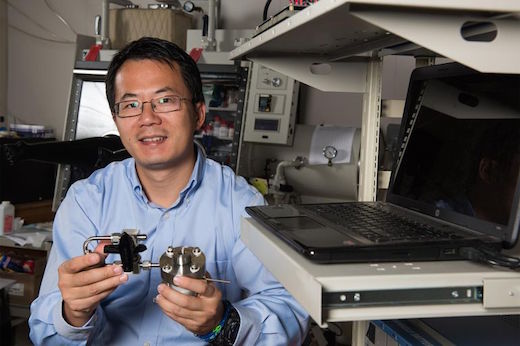
In October 2014, a team of scientists from Ohio State University revealed their design for a dye-sensitized solar cell that is able to store its own power. Now, they have reached a new milestone in that they have created a device, which fits a battery and solar cell into one. They have tested it against traditional lithium-iodine batteries and their findings reveal an energy savings of 20 percent.
The original battery was made up of three electrodes as opposed to four as is the case with a typical battery. It also featured a lithium plate base, and two layers of electrode separated by a thin sheet of porous carbon, as well as a titanium gauze mesh, which contains the dye-sensitive titanium dioxide photoelectrode.

The porous nature of the materials used to construct the battery enables the ions to oxidize into lithium peroxide. This is then chemically decomposed into lithium ions and stored as lithium metal. The researchers have now redesigned the battery and made it so that air no longer needs to pass through it for it to work.
The first version of the battery contained a conventional liquid electrolyte made up of salt and a solvent of perchlorate mixed with organic solvent dimethyl sulfoxide. They have now replaced this with water as the solvent and lithium iodide as the salt. This enables low-cost and high-energy storage capabilities. The final result is a water-based electrolyte and the new prototype battery is now classed as an aqueous flow battery.

Because it no longer needs air to pass through it, a solar panel can now be placed on top of it, which creates a single solid sheet. This still holds the dye-sensitized solar cells that the original battery did, for which the researchers used a red dye called ruthenium that can tune the wavelength of the light it captures.
To compare the performance of the new battery against the traditional lithium-iodine battery, the team tested it by charging and discharging them 25 times. The batteries released around 3.3 volts with each discharge. However, the new solar battery only needed to be charged to 2.9 volts to release the 3.3 volts, while the traditional battery had to be charged to 3.6 volts to discharge the same amount of voltage.
Needless to say, there is a big market for a battery that can both produce and store power. The researchers are currently still in the process of refining the design, and hope to one day bring it to market.
Related Articles on JetsonGreen.com:
Scientists Combine Solar Cell and Battery into a Single Highly Efficient Package
MIT Researchers Develop A More Efficient Battery
Car Tires Recycled into More Efficient Anodes for Batteries

Leave a Reply
You must be logged in to post a comment.